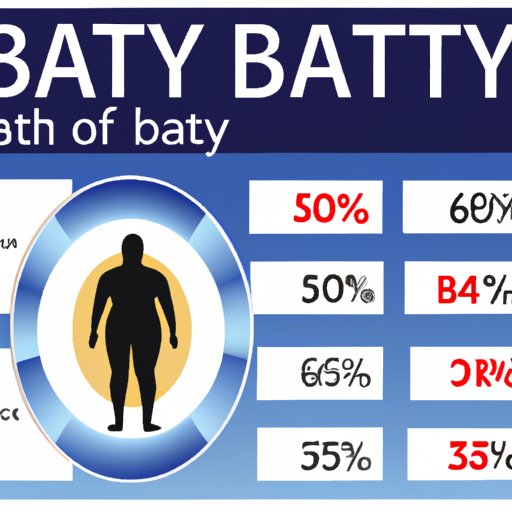Introduction
Body fat percentage is a measurement of the amount of fat mass a person has relative to their total body weight. This number can help you determine if your body composition is within a healthy range. The more body fat a person has, the higher their body fat percentage will be. Conversely, the leaner a person is, the lower their body fat percentage will be.
The American Council on Exercise (ACE) recommends that individuals aim for a certain body fat percentage based on their age and gender. Generally speaking, men should have a body fat percentage of between 10-20%, and women should have a body fat percentage of between 20-30%. However, these numbers can vary depending on a person’s age, body type, and lifestyle.

Analyzing Recommended Body Fat Percentages for Different Age Groups
The ACE recommends that individuals between the ages of 18-39 strive for a body fat percentage of between 8-19% for men and 21-32% for women. For individuals over the age of 40, the recommended body fat percentage is slightly higher, with men aiming for a body fat percentage of 11-22% and women aiming for a body fat percentage of 23-33%.
Research suggests that as a person ages, their body fat percentage naturally increases due to a decrease in muscle mass and an increase in fat mass. According to a 2016 study published in the journal Clinical Interventions in Aging, healthy older adults tend to have a higher body fat percentage than young adults. The study also found that older adults may need to adjust their dietary and exercise habits to maintain a healthy body fat percentage.

Exploring the Health Benefits of Maintaining a Healthy Body Fat Percentage
Maintaining a healthy body fat percentage can provide numerous health benefits. Studies show that having too much body fat can increase the risk of developing conditions such as heart disease, diabetes, and certain types of cancer. On the other hand, reducing excess body fat can reduce the risk of these conditions and improve overall health.
For example, a 2018 study published in the journal Obesity Reviews found that losing excess body fat can lead to improved blood sugar control, reduced inflammation, and better metabolic health. Additionally, the study suggests that reducing body fat can also reduce the risk of developing cardiovascular disease and type 2 diabetes.

Investigating the Role of Genetics in Determining an Ideal Body Fat Percentage
Genetics play an important role in determining an individual’s ideal body fat percentage. Studies suggest that people with a family history of obesity are more likely to have a higher body fat percentage than those without such a history.
At the same time, research shows that lifestyle choices can play an equally important role in achieving an optimal body fat percentage. Eating a balanced diet and engaging in regular physical activity can help individuals reach and maintain a healthy body fat percentage.
Comparing and Contrasting the Optimal Body Fat Percentages for Men and Women
Men and women tend to have different ideal body fat percentages. Generally speaking, men should have a body fat percentage of between 10-20%, while women should have a body fat percentage of between 20-30%. This difference is due to the fact that women typically carry more body fat than men.
In addition, studies suggest that the amount of body fat women carry is necessary for reproductive health. A 2018 study published in the journal Frontiers in Endocrinology found that women require a certain amount of body fat to produce hormones like estrogen, which is essential for ovulation and fertility.
Examining the Relationship Between Body Fat Percentage and Physical Performance
Having a healthy body fat percentage can also improve physical performance. Research suggests that athletes with a lower body fat percentage tend to have better aerobic performance, strength, and power than those with higher body fat percentages.
However, it’s important to note that having too little body fat can also be unhealthy. Studies suggest that athletes who have a body fat percentage below 5% may be at risk of developing health problems such as amenorrhea and osteoporosis.
Investigating the Impact of Diet and Exercise on Achieving a Healthy Body Fat Percentage
Diet and exercise are key components of achieving and maintaining a healthy body fat percentage. Eating a balanced diet composed of nutritious whole foods and limiting processed and sugary foods can help individuals reduce excess body fat. Additionally, engaging in regular physical activity can help burn calories and promote weight loss.
Studies suggest that high-intensity interval training (HIIT) is particularly effective for reducing body fat. HIIT is a type of exercise that involves alternating between short bursts of intense activity and periods of rest. A 2019 study published in the journal Medicine & Science in Sports & Exercise found that HIIT was more effective for reducing body fat than moderate-intensity exercise.
Conclusion
Achieving and maintaining a healthy body fat percentage can provide numerous health benefits. The American Council on Exercise recommends that individuals between the ages of 18-39 strive for a body fat percentage of between 8-19% for men and 21-32% for women. For individuals over the age of 40, the recommended body fat percentage is slightly higher, with men aiming for a body fat percentage of 11-22% and women aiming for a body fat percentage of 23-33%.
Genetics and lifestyle choices both play a role in determining an individual’s ideal body fat percentage. Eating a balanced diet and engaging in regular physical activity, such as high-intensity interval training, can help individuals reduce excess body fat and reach their optimal body fat percentage.
By following the recommendations outlined in this article, individuals can improve their overall health and physical performance by achieving and maintaining a healthy body fat percentage.
(Note: Is this article not meeting your expectations? Do you have knowledge or insights to share? Unlock new opportunities and expand your reach by joining our authors team. Click Registration to join us and share your expertise with our readers.)
